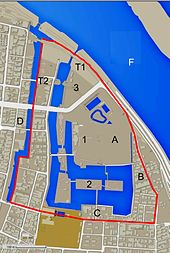Kuwana Castle
| Kuwana Castle | ||
|---|---|---|
|
Kuwana Castle behind the ferry. |
||
| Creation time : | before 1600 | |
| Castle type : | Hirajiro (Lower Castle) | |
| Conservation status: | Partly reconstructed | |
| Place: | Kuwana | |
| Geographical location | 35 ° 3 '52.7 " N , 136 ° 41' 55.4" E | |
|
|
||
The Castle Kuwana ( Japanese 桑名城 , Kuwana-jō ) is located in the city of Kuwana , Mie Prefecture , Japan . In the Edo period , a branch of the Hisamatsu Matsudaira resided there as the great Fudai daimyo .
Lords of the castle in the Edo period
- From 1601 Honda Tadakatsu with 100,000 Koku .
- From 1617 Hisamatsu-Matsudaira with 110,000 Koku
- From 1634 Hisamatsu-Matsudaira with 110,000 Koku
- From 1710 Okudaira with 100,000 Koku
- From 1823 Hisamatsu-Matsudaira with 110,000 Koku
history
In the years 1592 to 1594, Hitsuyanagi Naomori (1564–1694) had the castle tower relocated here from Kambe Castle. In 1601, Honda Tadakatsu (1548–1610), one of the "Four Kings of Heaven" under Tokugawa Ieyasu , received the castle and began to expand it.
The attachment
The castle, located at the mouth of the Ibi River ( 揖 斐川 , Ibi-gawa ), used this as a natural moat , with the Nagara River ( 長 良 川 , Nagara-kawa ) running parallel behind it . As usual, it consisted of the inner area, the Hommaru ( 本 丸 ) with the castle tower, which here in the north is the second area, the Ni-no-maru ( 二 の 丸 ), and in the south the third area, the San-no-maru ( 三 の 丸 ), connected. In the east, towards the river, the areas A: Uchi-asahi-maru ( 内 朝日 丸 ) and B: Soto-asahi-maru ( 外 朝日 丸 ) were upstream, in the west an offshoot of the San-no-maru. In the south the C: Kichi-no-maru ( 吉 の 丸 ) was upstream.
The castle tower (six-story inside, four-story from the outside) burned down in 1701 and was never rebuilt.
In the south, the castle was protected by the two moats Uchibori ( 内 堀 ) and Sotobori ( 外 堀 ). The long outer trench in the west with the name D: Siebenmeilen -Graben ( 七里 堀 , Shichiri-bori ) has largely been preserved. At its northern end was the T2: Mizu-no-ōmon ( 水 の 大門 ), which enabled direct access to the river. Another gate on the moat was the T2: north main gate ( 北大 手 門 , Kita-ōtemon ).
At the time of the Meiji Restoration , Prince Matsudaira Sadaaki ( 松 平 ierende 敬 ; 1847–1908) and his brother, Matsudaira Katamori , Prince of Aizu-Wakamatsu , were among the most loyal supporters of the Shogunate, and in contrast to the latter, he finally surrendered his castle without a fight . The buildings were demolished, the stones of the castle walls, like those of Kambe Castle, were used to build the port facilities of the city of Yokkaichi .
Today, apart from a few, in some cases wide, ditches and wall remnants on San-no-maru, hardly anything of the castle complex has been preserved. Part of it is now a public park.
photos
Remarks
- ↑ The name refers to the pier at the mouth of the canal for the ferries from the Miya post station in the Owari province .
- ↑ The name Tatsumi ( 辰 巳 ) indicates a location in the southeast after the twelve branches of the earth .
- ↑ The name of this watchtower means "ascending dragon". He was standing right by the river. Today's replica there houses the control of the lock inside.
Individual evidence
- ↑ a b c Sheet 42 "Kuwana" from various series of the 53 stations of Tōkaidō by ( Hiroshige ). The addition “Shichi-ri-watashi” is displayed in red.
literature
- Hashiba, Akira: Kuwana-jo in: Miura, Masayuki (ed.): Shiro to jinya. Saikoku-hen. Gakken, 2006. ISBN 978-4-05-604379-2 .
- Nishigaya, Yasuhiro (Ed.): Kuwana-jo. In: Nihon meijo zukan, Rikogaku-sha, 1993. ISBN 4-8445-3017-8 .
![Kuwana Castle behind the ferry. [1]](https://upload.wikimedia.org/wikipedia/commons/thumb/4/46/Hiroshige43_kuwana.jpg/300px-Hiroshige43_kuwana.jpg)






